Lights, Camera, Content Management!
Struggling to organize, distribute, and analyze your video content? A video content management system (VCMS) is your solution. This list presents the top 10 VCMS platforms—including Wistia, Vimeo Business, Brightcove, and more—to streamline your video strategy in 2025. Whether you're a small business or a large enterprise, discover the perfect VCMS to host, manage, and track your videos' performance, maximizing engagement and achieving your business goals. Find the right tool below and unlock your video content's full potential.
1. Wistia
Wistia stands out as a powerful video content management system (VCMS) specifically tailored for businesses seeking to leverage video for marketing, sales, and internal communication. It moves beyond simple video hosting, providing a robust suite of tools to create, manage, distribute, and analyze the performance of your video content. This platform prioritizes a high-quality viewing experience, brand consistency, and deep analytical insights, making it a top choice for organizations serious about video marketing. While it might come with a higher price tag than some basic video hosting platforms, its comprehensive features and focus on business needs justify the investment for those looking to maximize the impact of their video strategy. Wistia caters particularly well to publishers, media companies, content creation teams, ad sales teams, e-commerce businesses, and digital marketing teams seeking advanced analytics and control over their video content.
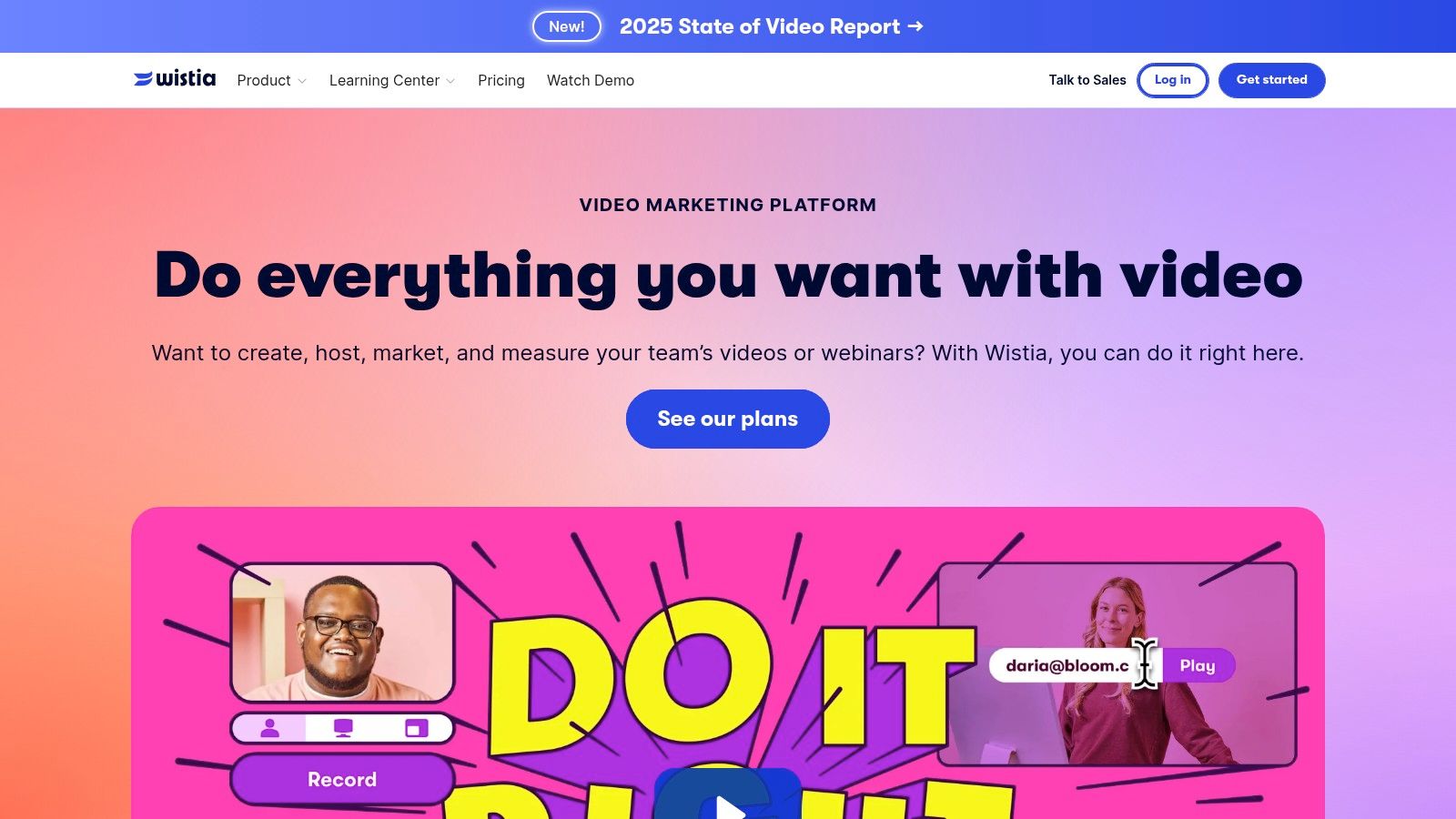
One of Wistia's key strengths lies in its advanced analytics. Forget simple view counts; Wistia provides in-depth heatmaps visualizing viewer engagement second by second. This granular data helps identify which parts of your videos resonate most with your audience, allowing you to refine your content strategy and improve viewer retention. For example, e-commerce teams can use heatmaps to understand how viewers interact with product demos, pinpointing areas of interest and potential confusion. Similarly, publishers can analyze how their audience engages with different segments of a news report, optimizing future content for maximum impact.
Wistia’s customization options are another major draw. The platform offers extensive control over the appearance of your video player, allowing you to customize colors, add your logo, and create a seamless brand experience. This is particularly valuable for publishers and media companies wanting to maintain a consistent brand identity across all their video content. Furthermore, Wistia's lead generation tools empower businesses to capture leads directly within the video player. Interactive elements like calls-to-action (CTAs) and forms can be embedded at strategic points, prompting viewers to take the next step in the sales funnel. This feature is particularly beneficial for marketing and sales teams looking to convert video viewers into qualified leads.
Beyond analytics and customization, Wistia excels in video SEO optimization. The platform automatically generates video sitemaps and provides tools to optimize video titles, descriptions, and tags, improving your content’s visibility in search engine results. This is crucial for any organization aiming to drive organic traffic through video content. Wistia also simplifies social sharing, allowing you to easily distribute your videos across various social media platforms. The inclusion of team collaboration tools and approval workflows further streamlines the video production process, facilitating efficient collaboration between content creation and editorial teams.
While Wistia’s robust features and performance justify its premium pricing, it's important to be aware of the potential drawbacks. Compared to basic video hosting solutions like YouTube or Vimeo, Wistia’s pricing plans are positioned at the higher end. Lower-tier plans also come with storage limitations, which might be a concern for businesses with extensive video libraries. Finally, while Wistia’s interface is generally user-friendly, mastering its advanced features might require a learning curve.
Implementation is relatively straightforward. Users can upload videos directly to the Wistia platform or embed existing videos from other sources. Wistia integrates seamlessly with popular marketing automation platforms and CRM systems, allowing you to track leads and analyze video performance within your existing marketing ecosystem. For specific technical requirements, it's best to consult Wistia's official documentation, which provides detailed information on supported video formats, encoding settings, and other technical specifications. You can explore their website for more details: https://wistia.com. In conclusion, if you’re seeking a professional video content management system with advanced analytics, customization options, and marketing tools, Wistia deserves serious consideration. While the pricing might be higher than basic solutions, the platform’s comprehensive features and focus on business needs make it a valuable investment for organizations looking to maximize the ROI of their video marketing efforts.
2. Vimeo Business
Vimeo Business stands out as a robust video content management system (VCMS) geared towards professionals seeking a high-quality, ad-free platform. It offers a comprehensive suite of tools for hosting, customizing, and analyzing video content, making it an excellent option for businesses, media companies, and creative professionals. Unlike free video hosting platforms, Vimeo Business prioritizes a clean, professional viewing experience, devoid of distracting advertisements. This focus on quality extends to its high-definition playback and robust privacy controls, enabling users to showcase their videos in the best possible light while maintaining control over their distribution. This makes it an ideal solution for those who value brand image and require granular control over their video content.

For publishers and media companies, Vimeo Business provides a reliable platform for distributing premium video content. The ad-free environment and advanced privacy settings allow for the creation of exclusive content libraries or paid subscription services. Editorial teams can leverage the platform's organization features to manage vast video archives, simplifying the process of locating and distributing specific clips. E-commerce teams can utilize Vimeo Business to host product demonstrations and tutorials, enhancing the customer experience and driving sales. Digital marketing teams can leverage the platform’s analytics to track video performance and refine their content strategies.
The platform shines with its advanced privacy controls. Users can password-protect videos, restrict embedding on certain websites, and even set geographical restrictions on who can view their content. This level of control is crucial for businesses that deal with sensitive information or wish to maintain tight control over their intellectual property. Customizable video players and embedding options allow users to seamlessly integrate videos into their websites and maintain brand consistency. Detailed analytics provide valuable insights into audience engagement, helping users understand which videos resonate most with their viewers. These insights can inform future content creation and distribution strategies. Live streaming capabilities and event management tools further extend the platform’s versatility, allowing businesses to connect with their audiences in real-time.
While Vimeo Business offers numerous advantages, it's essential to be aware of its limitations. The storage bandwidth can be restrictive on basic plans, potentially requiring users to upgrade to more expensive subscriptions for larger video libraries or higher traffic volumes. Compared to some specialized platforms, Vimeo Business may offer fewer marketing-specific features, like lead generation tools or direct integrations with marketing automation platforms. The higher cost for premium features might also be a consideration for smaller businesses or individuals on a tight budget. However, the robust feature set and ad-free experience often justify the cost for professional users.
Implementing Vimeo Business is relatively straightforward. The platform offers a user-friendly interface for uploading, organizing, and customizing video content. Integration with third-party tools, such as marketing automation platforms and CRM systems, further streamlines workflows. For example, you can easily connect your Vimeo account with your email marketing platform to automatically notify subscribers when new videos are released. Setting up custom branding for your video player is also simple and intuitive, ensuring a consistent brand experience across all your video content.
Vimeo Business's pricing is tiered, offering different plans to suit various needs. While specific pricing details can be found on their website (https://vimeo.com/business), generally, higher-tier plans offer increased storage, bandwidth, and advanced features. Technical requirements are minimal, primarily involving a stable internet connection for uploading and streaming videos. The platform is accessible through most modern web browsers and mobile devices, allowing users to manage their video content from anywhere.
Compared to platforms like YouTube, Vimeo Business offers a more professional, ad-free experience, albeit at a cost. YouTube’s vast reach and free hosting make it appealing for broader audiences, while Vimeo Business focuses on quality and control, catering to professional users. Wistia, another competitor, focuses on marketing-driven video hosting and offers more specialized features in that area. Choosing the right platform depends on your specific needs and priorities. If a clean, professional, and ad-free environment with robust privacy controls is paramount, Vimeo Business deserves strong consideration as your video content management system.
3. Brightcove
Brightcove stands as a leading enterprise-grade video content management system (VCMS), offering a comprehensive suite of tools for video hosting, streaming, analytics, and monetization. Designed specifically for large organizations and businesses with complex video needs, Brightcove provides a robust and scalable platform to manage high-volume video operations across the globe. Its feature-rich environment allows for extensive customization and integration, making it a powerful solution for publishers, media companies, and enterprise-level content creators. If your organization requires a sophisticated video platform capable of handling large libraries, high traffic, and advanced analytics, Brightcove warrants a closer look. This video content management system goes beyond basic video hosting and delves into a realm of powerful features and functionalities aimed at optimizing video performance and maximizing reach.
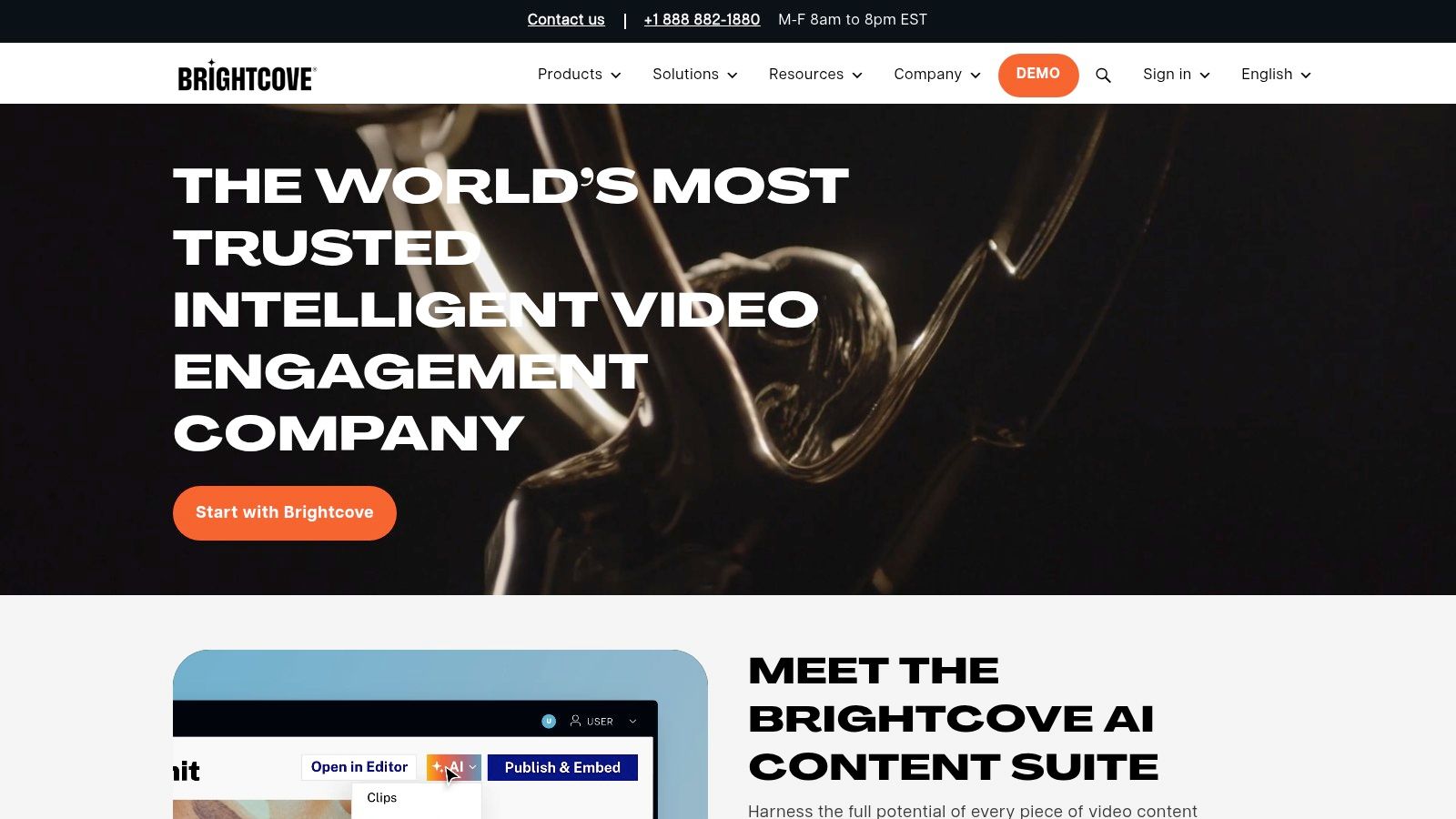
One of Brightcove's key strengths is its global content delivery network (CDN). This ensures optimal video playback performance for viewers worldwide, minimizing buffering and latency issues. For organizations with a global audience, this is critical for maintaining a high-quality viewing experience and maximizing engagement. Brightcove also offers robust APIs, allowing seamless integration with existing systems and workflows. This enables businesses to connect their video content management system with marketing automation platforms, CRM systems, and other critical business tools. These integrations streamline workflows, improve data analysis, and enhance the overall effectiveness of video marketing strategies.
Brightcove provides advanced analytics and reporting dashboards that offer valuable insights into viewer behavior and video performance. Data points such as viewer engagement, geographic distribution, and device usage can be tracked and analyzed, allowing organizations to understand their audience better and refine their video strategies. These data-driven insights are invaluable for optimizing content, targeting specific demographics, and maximizing the ROI of video investments. Beyond on-demand video, Brightcove also facilitates live streaming and virtual event hosting. This capability is particularly relevant for organizations hosting webinars, product launches, conferences, and other online events. Brightcove's platform provides the necessary tools and infrastructure to manage live streams effectively, ensuring smooth delivery and a high-quality viewing experience for attendees.
While Brightcove is a powerful video content management system, it's important to acknowledge its cost. The platform is designed for enterprise-level organizations and comes with a price tag to match. Smaller businesses or those with limited video needs may find the cost prohibitive. Additionally, the setup and configuration process can be complex, often requiring technical expertise and dedicated resources. This complexity can be a barrier for organizations lacking internal technical capabilities.
Practical Applications and Use Cases:
- Media and Broadcasting: Managing and distributing large volumes of video content across various platforms.
- Marketing and Advertising: Hosting marketing videos, product demos, and customer testimonials.
- Enterprise Communications: Internal training videos, corporate announcements, and town hall meetings.
- E-learning and Education: Delivering online courses, lectures, and educational materials.
Pricing: Brightcove offers tailored pricing based on specific needs and usage. Contact their sales team for a custom quote.
Technical Requirements: Specific technical requirements vary depending on the chosen features and integrations. Consult Brightcove’s documentation for detailed information.
Implementation and Setup Tips:
- Plan your video strategy: Define your goals, target audience, and content strategy before implementing Brightcove.
- Utilize Brightcove’s professional services: Leverage their expertise for initial setup, configuration, and training.
- Integrate with existing systems: Connect Brightcove with your CRM, marketing automation, and other relevant platforms.
- Optimize video content for various devices and platforms: Ensure your videos are accessible and engaging on all devices.
Brightcove (https://www.brightcove.com) is undoubtedly a powerful player in the video content management system arena. Its robust features, global reach, and advanced analytics make it an excellent choice for large organizations with sophisticated video needs. However, its complexity and cost make it less suitable for smaller businesses. Careful consideration of your specific requirements and budget is essential before committing to this powerful platform. If your organization requires enterprise-grade video management, Brightcove is a compelling option that deserves serious consideration.
4. JW Player
JW Player is a robust and versatile video content management system (VCMS) ideal for businesses of all sizes looking for a comprehensive solution for hosting, streaming, and analyzing their video content. From individual content creators to large media companies, JW Player offers a scalable platform that can adapt to evolving needs. It distinguishes itself from other video content management system solutions through its focus on reliability, performance, and a wide array of features suitable for various video strategies. Its adaptable player, robust analytics, and live streaming capabilities make it a compelling choice for those serious about leveraging video content.
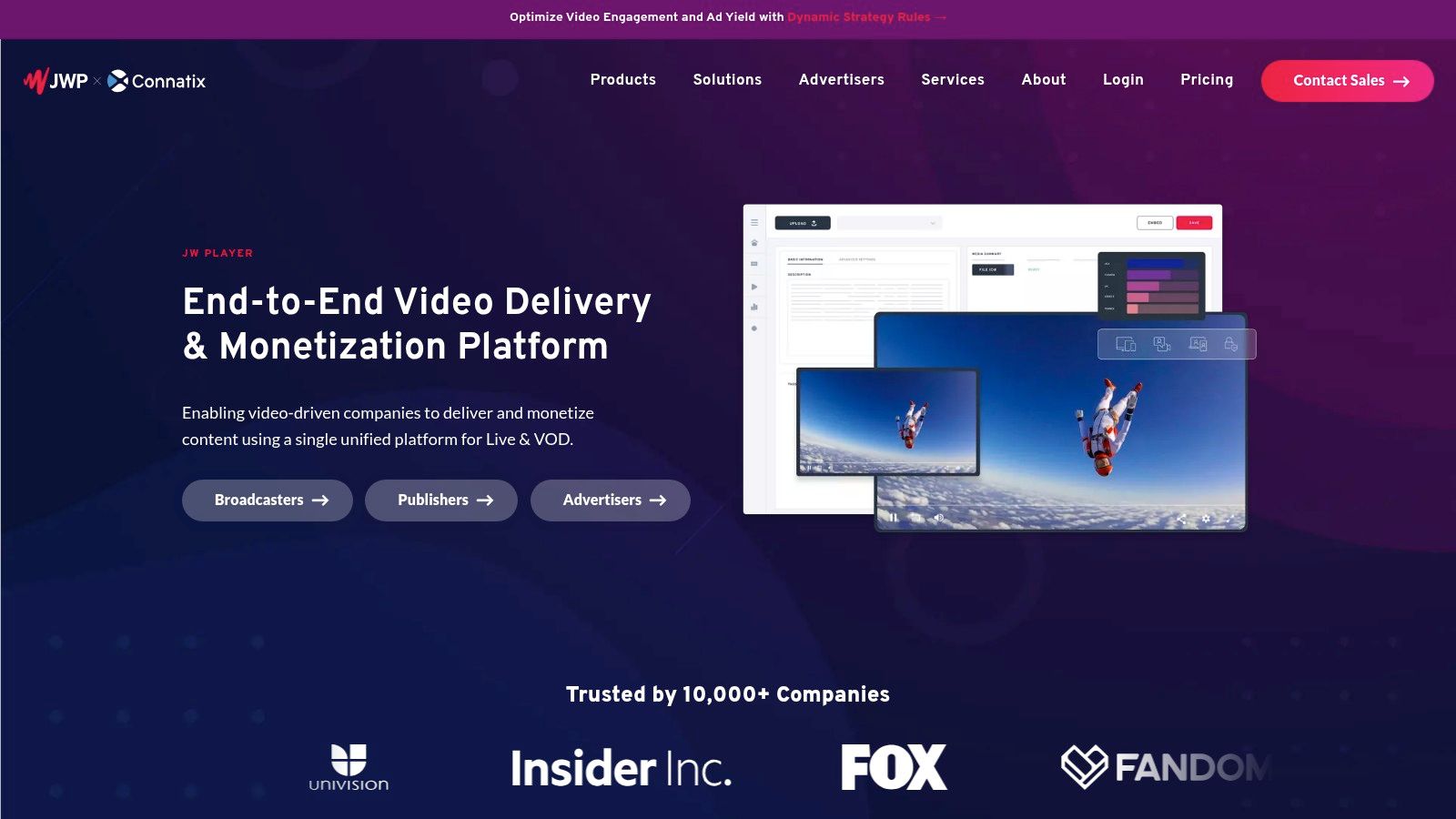
One of JW Player's core strengths lies in its adaptive streaming technology. This ensures optimal video quality across a diverse range of devices, from desktops and laptops to smartphones and tablets. Whether your audience is watching on a high-speed connection or dealing with limited bandwidth, JW Player automatically adjusts the video quality to provide a smooth, buffer-free viewing experience. This is crucial for maximizing reach and engagement in today’s multi-device world. For publishers and media companies, this translates to a broader audience reach and increased viewership. E-commerce teams can leverage this feature to showcase product demos seamlessly, regardless of the customer's internet connection.
Beyond simple video playback, JW Player provides comprehensive analytics and performance metrics. This data-rich environment empowers content creators, digital marketing teams, and ad sales teams to understand viewer behavior, track video performance, and make data-driven decisions to optimize their content strategy. Metrics like play rate, engagement, and geographic distribution provide valuable insights into audience preferences and content effectiveness. This data can be instrumental in refining content strategies, targeting specific demographics, and demonstrating ROI to stakeholders. For example, ad sales teams can leverage these analytics to demonstrate ad performance and attract premium advertisers.
Live streaming and video-on-demand (VOD) capabilities further enhance JW Player's versatility. For media companies and content creation teams, this offers the flexibility to engage audiences in real-time through live events, webinars, or broadcasts, while simultaneously maintaining a library of on-demand content for viewers to access at their convenience. This dual functionality caters to diverse content strategies and expands audience engagement opportunities. Furthermore, the customizable video players allow for branding and seamless integration into existing websites and applications, ensuring a consistent brand experience across all platforms. Content protection and Digital Rights Management (DRM) capabilities are also available, safeguarding valuable video assets from unauthorized access and distribution. This is especially crucial for publishers and media companies who need to protect their copyrighted material.
While JW Player offers a wealth of powerful features, it’s important to consider the potential drawbacks. The interface can be somewhat complex for non-technical users, potentially requiring a learning curve for some team members. Compared to some competitors, the built-in marketing tools are relatively limited, and some advanced features, like advanced analytics and DRM, require higher-tier subscription plans. However, the platform’s robust technical documentation and dedicated customer support help mitigate these challenges.
Learn more about JW Player for a more detailed overview.
JW Player offers flexible pricing options to accommodate various budgets and business needs. While specific pricing details are available on their website, the platform generally offers tiered plans based on features and usage. Factors such as video storage, bandwidth consumption, and the number of video plays often influence the pricing structure. This scalability makes it a viable option for businesses ranging from startups to enterprise-level organizations. For those interested in exploring the platform firsthand, a free trial is typically available to test its functionality and determine its suitability for specific requirements.
Implementing JW Player is generally straightforward. The platform provides detailed documentation and developer resources to guide users through the integration process. Typically, this involves embedding a code snippet into your website or application. For more complex integrations or custom development, JW Player offers APIs and SDKs for seamless integration with existing systems. This robust technical support makes the setup process relatively smooth, even for users with limited technical expertise. With its comprehensive features, robust performance, and flexible pricing, JW Player deserves its place amongst the top video content management systems available. It provides a powerful solution for managing, distributing, and monetizing video content, empowering businesses to harness the full potential of video in their digital strategies.
5. Kaltura: A Powerful Open-Source Video Content Management System
Kaltura stands out as a robust and versatile video content management system (VCMS) catering to a diverse range of users, from large enterprises and educational institutions to media companies and small businesses. Its open-source nature combined with the availability of both cloud-based and on-premise deployments makes it a highly adaptable solution for organizations with varying needs and technical capabilities. This flexibility allows users to tailor the platform to their specific workflows and integrate it seamlessly into existing systems. For organizations prioritizing security and compliance, Kaltura offers granular control over their video content and infrastructure, a crucial factor in today's digital landscape. If you're searching for a video content management system that can truly grow and adapt with your organization, Kaltura is certainly worth considering.

Kaltura's comprehensive suite of features covers the entire video lifecycle, from creation and management to delivery and analysis. Its advanced video editing and collaboration tools empower teams to create high-quality content, while the platform's robust streaming capabilities ensure smooth and reliable delivery to any device. For data-driven decision-making, Kaltura offers in-depth analytics and reporting, providing valuable insights into viewer engagement and content performance. Furthermore, its integration with learning management systems (LMS) and other enterprise tools makes it an ideal solution for educational institutions and businesses seeking to leverage video for training, communication, and collaboration. For a broader overview of video content management systems and their strategic implementation, learn more about Kaltura and other VCMS options.
One of Kaltura's key strengths lies in its open-source foundation, offering unparalleled customization flexibility. Developers can access the source code, modify existing features, and build new functionalities to meet specific requirements. This level of control is especially beneficial for organizations with unique workflows or integration needs. However, this flexibility comes with a trade-off. Setting up and customizing a self-hosted Kaltura instance requires significant technical expertise. For organizations lacking in-house development resources, the cloud-based version offers a more manageable alternative.
Kaltura's dual deployment options cater to a wide spectrum of organizations. The cloud-based solution provides a quick and easy setup with minimal technical overhead, while the on-premise option offers greater control over security and infrastructure. This makes Kaltura suitable for both organizations seeking a hassle-free video content management system and those with stringent security or compliance regulations. For example, a media company might opt for the on-premise deployment to maintain complete control over its valuable video assets, while a small business might choose the cloud-based version for its simplicity and scalability.
While Kaltura's pricing isn't publicly available, it typically follows a subscription-based model for the cloud-based version, with pricing tiers based on features, storage, and bandwidth usage. For on-premise deployments, licensing fees and support costs vary depending on the specific requirements. For smaller businesses with basic video hosting needs, Kaltura's complexity and potential cost might be overkill. Simpler, more user-friendly platforms might be a better fit for such scenarios.
For organizations considering Kaltura, a few implementation tips can streamline the process. First, clearly define your video strategy and objectives. Identify your target audience, content types, and desired outcomes. This will help you determine the necessary features and deployment model. Second, evaluate your technical resources. If opting for the on-premise deployment, ensure you have the necessary expertise to manage and maintain the system. Finally, leverage Kaltura’s active community and developer support resources. The community forums and documentation offer valuable insights and assistance for troubleshooting and customization.
In conclusion, Kaltura is a powerful and flexible video content management system that excels in customization, security, and scalability. Its open-source nature, dual deployment options, and comprehensive features make it a compelling choice for a diverse range of organizations. While its complexity and potential cost might be a barrier for smaller businesses with basic needs, Kaltura's robust capabilities make it a top contender for larger organizations requiring a sophisticated and adaptable video platform.
6. Panopto: A Robust Video Content Management System for Education and Training
Panopto stands out as a leading video content management system (VCMS) meticulously crafted for the specific needs of educational institutions and corporate training environments. While other VCMS platforms cater to broader business applications, Panopto focuses on optimizing video learning and knowledge sharing. This specialization allows it to offer powerful features for lecture capture, video streaming, and building searchable video libraries that enhance knowledge accessibility and retention. Its robust features like automatic transcription, smart search within videos, and seamless integration with learning management systems (LMS) make it an invaluable tool in the modern educational landscape.

For educational publishers seeking to create and distribute video learning resources, Panopto provides a comprehensive platform. It empowers content creation teams to record lectures, presentations, and demonstrations with ease, while its automated transcription and closed captioning features ensure accessibility and broader reach. Editorial teams can leverage Panopto’s advanced video editing capabilities to refine content and ensure quality. The seamless integration with LMS platforms streamlines the delivery of educational content directly to students, creating a unified learning experience.
Similarly, media companies specializing in educational content can use Panopto to manage and distribute their video assets effectively. Its robust search functionality enables viewers to easily locate specific information within videos, increasing engagement and knowledge retention. Advanced video analytics provide valuable insights into viewer behavior, helping content creators understand what resonates with their audience and optimize future content accordingly.
Within corporate training environments, Panopto facilitates the creation and delivery of engaging training programs. From onboarding new hires to upskilling existing employees, Panopto's lecture capture and screen recording capabilities allow trainers to capture knowledge effectively. The platform's smart search functionality transforms video libraries into searchable knowledge bases, allowing employees to quickly find answers to their questions and access relevant training materials on demand. This feature is particularly beneficial for e-commerce and digital marketing teams, who require ongoing training to keep up with rapidly evolving industry trends. Panopto's integration with LMS systems simplifies the tracking of employee progress and ensures consistent training delivery across the organization.
While Panopto’s strength lies in its education and training focus, this specialization can also be a limiting factor. It might not be the ideal choice for general business use cases like marketing videos or internal communications that require more versatile editing and distribution options. Furthermore, while Panopto’s advanced features are incredibly powerful, they can also present a steeper learning curve for some users. Smaller organizations might also find the pricing structure to be a significant investment. While specific pricing is not publicly available, it is typically based on the number of users and features required.
Implementing Panopto typically involves working with their team to determine the best configuration for your specific needs. They provide support for integration with existing LMS systems and offer training resources to help users maximize the platform's potential. Technical requirements are relatively standard, primarily requiring a stable internet connection and compatible browsers for both content creators and viewers.
Compared to more general-purpose VCMS platforms like Vimeo or Wistia, Panopto offers a more specialized and feature-rich environment for educational and training content. While Vimeo and Wistia provide excellent video hosting and marketing tools, they lack Panopto's deep integration with educational platforms and its advanced search and accessibility features.
In conclusion, Panopto earns its place on this list by offering a powerful and specialized video content management solution tailored to the unique needs of educational institutions and corporate training departments. Its robust features, particularly in search, accessibility, and LMS integration, make it an invaluable tool for enhancing learning and knowledge sharing within these specific contexts. While its specialized focus and pricing might make it less suitable for smaller organizations or those with more general business video needs, for organizations prioritizing video-based learning and training, Panopto provides a compelling and comprehensive platform. You can explore their offerings further at https://www.panopto.com.
7. Vidyard
Vidyard stands out as a powerful video content management system (VCMS) specifically tailored for sales and marketing teams. While a comprehensive video content management system addresses the needs of various teams, Vidyard focuses on leveraging video for lead generation, customer engagement, and driving sales. This makes it a unique and highly effective tool for businesses that prioritize video in their sales and marketing strategies. It goes beyond basic video hosting and delves into personalized video experiences, detailed analytics, and seamless integrations with existing business tools. This targeted approach is what sets Vidyard apart and earns it a spot on this list.
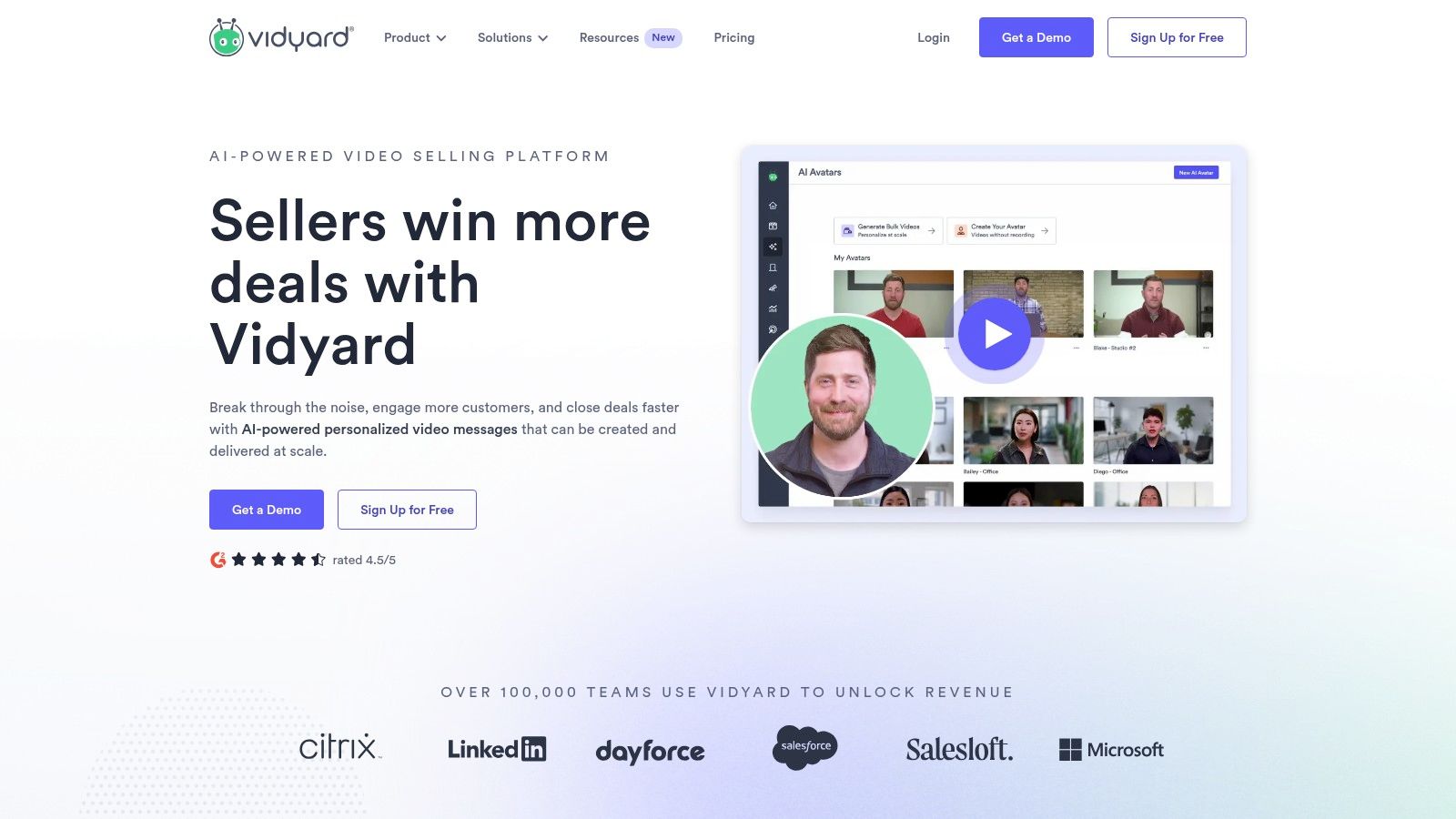
Vidyard's core strength lies in its personalized video messaging capabilities. Sales teams can create and send individual video messages directly to prospects, adding a human touch to outreach and significantly increasing engagement. Marketing teams can personalize video content for different audience segments, tailoring their messaging for maximum impact across various campaigns. Imagine sending a personalized video thank you after a demo or embedding a product explainer video within a targeted email campaign. These capabilities enable businesses to connect with their audience on a deeper level, nurturing leads and fostering stronger relationships.
Beyond personalized messaging, Vidyard provides robust analytics that offer deep insights into viewer behavior. It goes beyond basic view counts and provides detailed metrics such as watch time, engagement drop-off points, and individual viewer actions. This granular data helps businesses understand how viewers interact with their videos, identify areas for improvement, and optimize their video content strategy for better results. This level of insight is invaluable for data-driven decision-making and refining video content for optimal performance.
Seamless integration with existing CRM and marketing automation tools is another key feature. Vidyard integrates with platforms like Salesforce, Marketo, and HubSpot, allowing businesses to streamline their workflows and leverage video data within their existing sales and marketing processes. For instance, a sales team can track video engagement within Salesforce and use that data to prioritize follow-up efforts, leading to more efficient lead nurturing and increased conversion rates. Learn more about Vidyard's specific implementation strategies and best practices for maximizing your video content ROI at Learn more about Vidyard.
For publishers, media companies, and content creation teams, Vidyard's advanced analytics can help understand audience preferences and optimize video content for better engagement. E-commerce teams can leverage personalized video messages to enhance product demonstrations and drive sales. Digital marketing teams can integrate Vidyard with their marketing automation platforms to personalize video content within email campaigns and track the impact on lead generation.
While Vidyard excels in its sales and marketing focus, it's important to be aware of its limitations. Its general video management features are less comprehensive than some other VCMS platforms. For example, features like advanced video editing or complex content categorization may be limited. Additionally, pricing can be a consideration, particularly for smaller businesses or those requiring only basic video hosting and management features. Advanced features and larger user licenses typically come at a higher price point. Finally, Vidyard's primary focus is on B2B use cases, so its suitability for other applications should be carefully considered.
Vidyard offers several pricing tiers, starting with a free trial and ranging up to enterprise-level plans. The specific features and storage limits vary depending on the chosen plan, allowing businesses to select the option that best fits their needs and budget. Technical requirements are minimal, as Vidyard is a cloud-based platform accessible through a web browser. Implementation is typically straightforward, and the user-friendly interface makes it accessible even for non-technical users. This ease of use is a significant advantage for teams looking to quickly implement and leverage the power of video without extensive technical expertise. For businesses heavily invested in video as a sales and marketing tool, Vidyard’s focused features and deep integrations make it a valuable asset for driving engagement, generating leads, and ultimately, boosting sales.
8. Sprout Video
Sprout Video is a robust video content management system (VCMS) specifically designed for businesses that prioritize security, customization, and in-depth analytics. It offers a compelling blend of professional features and user-friendliness, making it an ideal choice for organizations looking for a secure and insightful way to manage and distribute their video content. Unlike some free video hosting platforms, Sprout Video focuses on providing a controlled environment for video assets, enabling businesses to leverage video for marketing, internal communication, and sales enablement without compromising on privacy or branding consistency. Its features cater to a range of use cases, from hosting private training videos for employees to embedding marketing videos on a company website with lead capture forms.

Sprout Video earns its place on this list due to its strong focus on privacy and security, coupled with its detailed analytics capabilities. For publishers, media companies, and content creation teams, this means having granular control over who accesses their video content. This is particularly crucial for premium content, internal communications, or pre-release materials. E-commerce teams can utilize Sprout Video to host product demos and tutorials securely, tracking viewer engagement to optimize their video marketing strategies. Ad sales teams benefit from the detailed viewer analytics, enabling them to demonstrate the effectiveness of video advertising campaigns to potential clients. Furthermore, the platform's customizable video players allow businesses to maintain brand consistency across all their video content, a feature highly valuable for digital marketing and editorial teams.
One of Sprout Video's core strengths lies in its advanced privacy controls. Features like password protection, domain restrictions, and geographical blocking provide several layers of security, ensuring that your videos are only accessible to the intended audience. This is a significant advantage over platforms like YouTube or Vimeo, where content visibility is less controllable. For instance, a company using Sprout Video can create a password-protected library of training videos exclusively for its employees, ensuring that confidential information remains secure. Similarly, marketing teams can restrict video embeds to specific domains, preventing unauthorized use and maintaining brand integrity.
Beyond security, Sprout Video provides detailed viewer analytics, offering valuable insights into audience behavior. Metrics like video views, play rates, and engagement data help businesses understand how their videos are performing and identify areas for improvement. This data is crucial for optimizing video content, tailoring messaging to specific audience segments, and measuring the ROI of video marketing campaigns. For example, an e-commerce team can analyze which product demo videos are generating the most engagement and use this information to refine their sales strategy.
Implementing Sprout Video is relatively straightforward. The platform boasts a user-friendly interface that simplifies the upload, organization, and management of video content. Customization options are readily accessible, allowing users to brand their video players and embed videos seamlessly into their websites. While pricing information isn't readily available on their marketing materials, Sprout Video offers various subscription plans tailored to different business needs. Contacting their sales team is recommended for specific pricing details and to discuss which plan aligns best with your requirements. Technical requirements are minimal, primarily involving a stable internet connection for uploading and viewing videos.
While Sprout Video excels in security, analytics, and ease of use, it's essential to acknowledge its limitations. Compared to enterprise-level video content management systems, it offers fewer advanced features, such as complex video editing tools or extensive live streaming capabilities. Its live streaming functionality is quite basic, making it less suitable for businesses that rely heavily on live video broadcasts. Additionally, Sprout Video has smaller brand recognition compared to some of the larger players in the market. However, for small to medium-sized businesses seeking a secure, user-friendly, and analytics-rich video content management system, Sprout Video offers a compelling solution. Its robust privacy features, detailed analytics, and customizable branding options make it a valuable tool for a variety of applications, justifying its place on this list. For further information and to explore its features in detail, visit their website: https://sproutvideo.com.
9. Dacast
Dacast is a robust video streaming and content management platform specializing in live streaming and video-on-demand (VOD) services. Its comprehensive suite of tools caters to a wide range of users, from individual content creators to large media companies seeking a reliable video content management system. Dacast distinguishes itself by offering white-label solutions and various monetization options, making it a compelling choice for those looking to generate revenue from their video content. Its focus on delivering a high-quality viewing experience is backed by a robust global content delivery network, ensuring smooth playback for audiences worldwide. This platform is particularly well-suited for organizations and individuals prioritizing live streaming and revenue generation from their video assets.
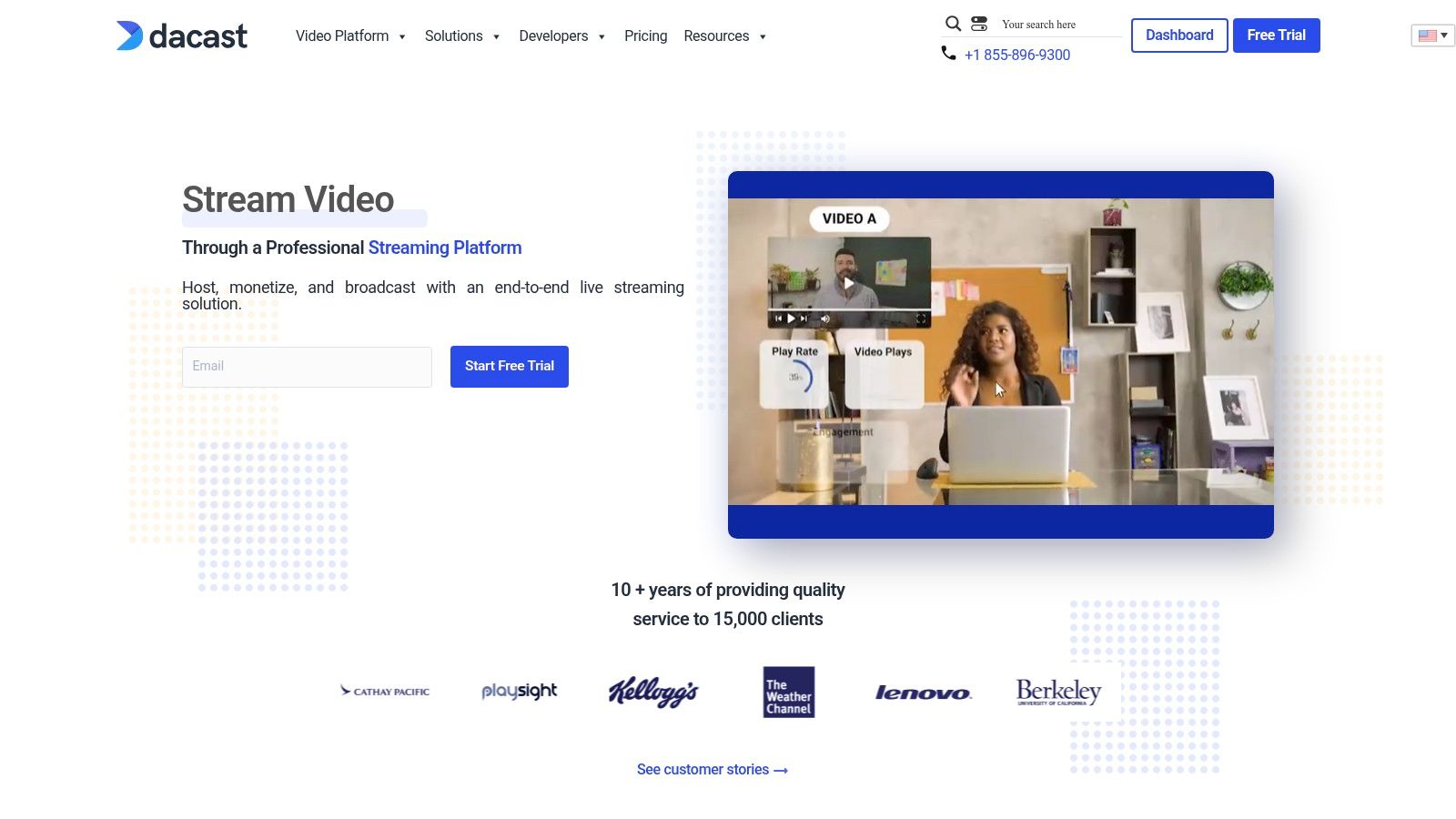
Dacast’s strength lies in its live streaming capabilities. It offers features like real-time analytics, allowing broadcasters to monitor viewer engagement and adjust their content strategy accordingly. The platform supports various streaming protocols and provides adaptive bitrate streaming, ensuring optimal playback quality across different devices and bandwidths. This makes it an ideal video content management system for live events, webinars, conferences, and even 24/7 broadcasting. Beyond live streaming, Dacast also provides robust VOD hosting and management, allowing users to build extensive video libraries accessible on demand.
For content creators and businesses focused on monetization, Dacast offers several integrated options. These include pay-per-view, subscriptions, and advertising integrations, giving users flexibility in how they monetize their content. The white-label functionality allows businesses to brand their video portal fully, creating a seamless and professional experience for their audience. This is particularly valuable for e-commerce teams using video for product demonstrations or for digital marketing teams running online courses and training sessions. Publishers and media companies can leverage Dacast to deliver premium content behind a paywall, creating new revenue streams and strengthening their brand identity.
While Dacast offers a competitive feature set for video streaming and monetization, it's important to be aware of some limitations. Compared to full-fledged content management systems (CMS) like WordPress or Drupal, Dacast's content management capabilities are more streamlined. It focuses primarily on video management and doesn't offer the same depth of features for managing other types of content like blog posts or articles. The user interface, while functional, could be more intuitive for beginners, especially those unfamiliar with video streaming platforms. Finally, compared to some other platforms, Dacast offers fewer direct integrations with marketing automation tools.
Dacast offers several pricing tiers to accommodate different needs and budgets. The Starter plan provides a good entry point for individuals and small businesses, while the Scale and Event plans offer increased bandwidth, storage, and advanced features for larger organizations and high-volume streaming. It’s advisable to check their website (https://www.dacast.com) for the latest pricing and plan details.
Implementing Dacast is relatively straightforward. The platform provides comprehensive documentation and good technical support to assist users during setup and ongoing operation. For live streaming, you'll need encoding software and a stable internet connection. Dacast supports various encoders and provides guidance on choosing the right one for your needs. For VOD, uploading content is a simple process through the platform's interface.
Dacast's value proposition within the landscape of video content management systems stems from its strong focus on live streaming, flexible monetization options, and white-label capabilities. While not a full-fledged CMS, it excels as a video-centric platform for those prioritizing live broadcasting and revenue generation. Its competitive pricing and reliable infrastructure make it a viable option for various organizations, from small businesses to large media companies. Content creation teams, ad sales teams, and editorial teams can leverage Dacast to streamline their video workflows and maximize the reach and impact of their content.
10. Cincopa
Cincopa positions itself as a comprehensive multimedia content management system (video CMS), handling not only video but also audio, images, and other media formats within a single platform. This unified approach makes it a potentially attractive option for businesses, photographers, and content creators seeking a centralized hub for all their multimedia assets. While it may not offer the hyper-specialized video features of some dedicated video content management systems, its breadth of functionality makes it a versatile tool for organizations managing diverse content types. Cincopa's focus on ease of use, combined with customizable galleries and media players, allows for professional presentation and efficient content organization. This makes it a valuable option for teams looking to streamline their workflows and enhance their online presence.
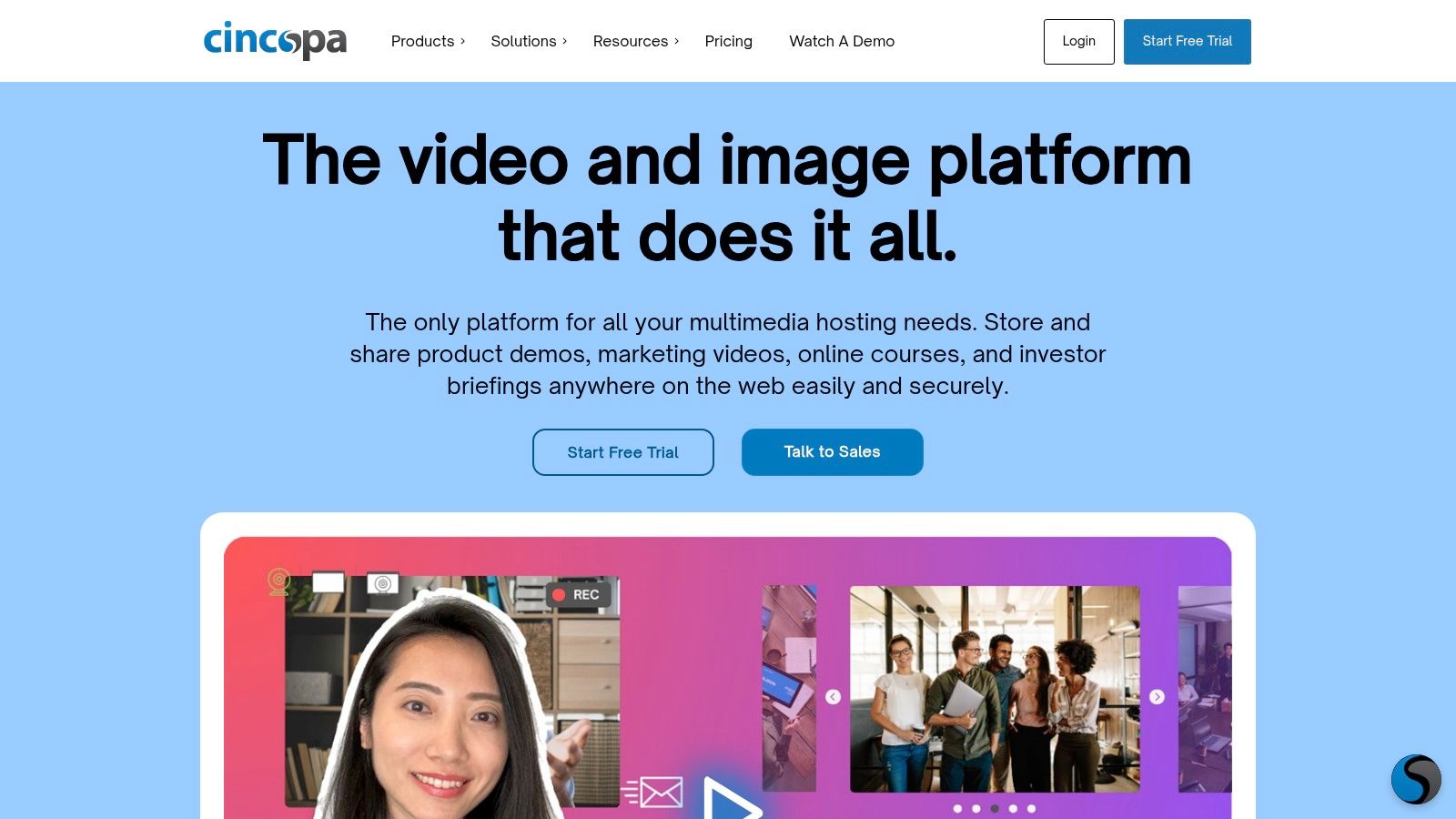
For publishers, Cincopa offers a streamlined way to manage and showcase a diverse portfolio of multimedia content. Imagine seamlessly integrating video interviews alongside written articles and photo galleries within a single article. Media companies can leverage Cincopa to create rich media experiences, embedding videos, podcasts, and image galleries within their online publications. This diversified approach allows for more engaging storytelling and can contribute to increased audience engagement. Content creation teams, often juggling various media formats, can benefit from Cincopa's unified platform. The centralized system simplifies content organization, making it easier to find, manage, and deploy assets across different channels.
For Ad Sales teams, Cincopa’s multimedia galleries can serve as compelling portfolios to showcase the range of advertising options available to potential clients. Interactive galleries featuring video ads and other rich media formats can demonstrate the impact and reach of their advertising solutions. Editorial teams can utilize Cincopa’s password protection and privacy control features to manage pre-release content or exclusive materials for subscribers. This ensures secure access and allows for controlled distribution of sensitive content.
E-commerce teams can enhance product presentations by incorporating videos and high-resolution images directly on product pages. Cincopa’s customizable players and galleries allow for seamless integration with existing e-commerce platforms, enriching the customer experience and potentially driving sales. Digital marketing teams can leverage Cincopa's social media integration and analytics features to track the performance of their multimedia campaigns. Sharing options simplify distribution across various social platforms, while analytics provide valuable insights into viewer engagement and content effectiveness.
Cincopa offers several key features that contribute to its value proposition. The platform provides customizable galleries and media players, allowing users to tailor the presentation of their content to match their branding. Password protection and privacy controls provide options for securing sensitive material, while social media integration streamlines content sharing across various platforms. Analytics and viewer engagement tracking tools provide valuable data for optimizing content strategies and understanding audience behavior.
One of Cincopa's strengths lies in its unified platform approach. Managing all media types in a single system simplifies workflows and reduces the need for multiple, disparate tools. The platform also offers a good variety of templates and customization options, allowing users to create visually appealing and professional presentations. Cincopa is generally considered affordable, especially for small businesses, making it an accessible option for organizations with limited budgets. The user interface is designed for ease of use, simplifying content organization and management tasks.
However, Cincopa does have some limitations. As a general multimedia platform, it may not offer the depth of video-specific features found in dedicated video content management systems like Brightcove or Kaltura. Users seeking advanced video editing, transcoding, or streaming capabilities might find Cincopa's offerings less comprehensive. The platform also has a smaller ecosystem of integrations compared to some competitors, which could limit its extensibility and connectivity with other business tools.
While Cincopa's pricing details are readily available on their website (https://www.cincopa.com), specific technical requirements are less explicit. Generally, users will need a stable internet connection for uploading and managing content. The platform is browser-based, so no specific software installations are typically required. Implementing Cincopa is relatively straightforward. Users create an account, upload their media files, and then customize the appearance and functionality of their galleries and players. Embedding media onto websites or other platforms is typically achieved through embed codes provided by the platform.
Cincopa deserves its place in this list because it provides a valuable balance between functionality and ease of use. While it might not be the ideal solution for organizations requiring highly specialized video features, its comprehensive multimedia approach, combined with affordable pricing and a user-friendly interface, makes it a compelling option for a broad range of users managing diverse content portfolios. Its strengths lie in its unified platform, customization options, and ease of implementation, making it a practical choice for streamlining multimedia content management workflows.
Top 10 Video CMS Feature Comparison
| Platform | Core Features & Highlights | User Experience & Quality ★ | Value & Pricing 💰 | Target Audience 👥 | Unique Selling Points ✨ |
|---|---|---|---|---|---|
| Wistia | Advanced analytics, customizable players, lead gen tools | Excellent quality, fast loading ★★★★ | Higher pricing, limited low-tier storage 💰💰💰 | Businesses focused on marketing & branding 👥 | Marketing integration, detailed insights ✨🏆 |
| Vimeo Business | Ad-free hosting, privacy controls, live streaming | High-quality playback ★★★★ | Premium cost for features 💰💰 | Professional businesses, content creators 👥 | Strong privacy, clean interface ✨ |
| Brightcove | Enterprise-scale streaming, global CDN, robust APIs | Highly scalable, global delivery ★★★★ | High cost, enterprise-focused 💰💰💰💰 | Large enterprises with complex needs 👥 | Scalable infrastructure, SLA support ✨🏆 |
| JW Player | Adaptive streaming, live/VOD, content protection | Reliable delivery, strong performance ★★★ | Flexible pricing 💰💰 | All business sizes, developers 👥 | Performance optimization, DRM support ✨ |
| Kaltura | Open-source, cloud & on-premise, advanced editing | Customizable, strong security ★★★ | Varies by deployment, technical setup 💰💰 | Enterprises, education, media 👥 | Open-source flexibility, compliance ✨ |
| Panopto | Transcription, smart search, lecture capture | Strong accessibility ★★★ | Can be expensive 💰💰💰 | Education & corporate training 👥 | Auto transcription, searchable libraries ✨ |
| Vidyard | Personalized video messaging, CRM integrations | User-friendly for marketing ★★★★ | Premium pricing for advanced features 💰💰💰 | Sales & marketing teams 👥 | Sales enablement, video coaching ✨🏆 |
| Sprout Video | Privacy controls, lead capture, domain restrictions | Easy setup, strong security ★★★ | Competitive for SMBs 💰💰 | Small-medium businesses 👥 | Privacy focus, good support ✨ |
| Dacast | Live streaming, monetization, global CDN | Reliable streaming ★★★ | Competitive pricing 💰💰 | Content creators, broadcasters 👥 | Monetization options, white-label ✨ |
| Cincopa | Multimedia management, galleries, social sharing | User-friendly, good templates ★★★ | Affordable for small biz 💰 | Small businesses, content creators 👥 | Multi-media platform, gallery customization ✨ |
Ready to Take Your Video Content to the Next Level?
Choosing the right video content management system (VCMS) is paramount to a successful video strategy. We've explored ten powerful platforms, from established players like Wistia, Vimeo Business, Brightcove, JW Player, and Kaltura, to specialized solutions such as Panopto for education, Vidyard for sales, Sprout Video for small businesses, Dacast for live streaming, and Cincopa for diverse media management. Each offers unique features and capabilities catering to different needs and budgets. Remember to consider factors like scalability, integration options, analytics, and security when making your decision. Creating high-quality video content is essential for sharing product demos and tutorials. If you're looking for tools to help you produce professional-grade videos, check out this guide to the top 10 video screen recorder software.
Your VCMS will become the backbone of your video operations, enabling you to organize, manage, distribute, and analyze your video content effectively. Choosing the correct system, whether it's a robust platform for enterprise-level distribution or a more streamlined solution for a smaller team, empowers you to reach wider audiences and achieve your video marketing goals.
Take your video content strategy even further with Aeon. Aeon complements your video content management system by offering innovative video creation tools that transform your existing text, video, and audio content into engaging videos, enhancing your digital presence and driving measurable results. Learn more about revolutionizing your video content creation process with Aeon.